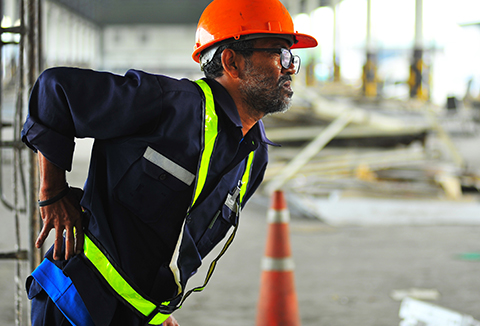Perhaps the most common work-related injuries include those affecting the spine. Regardless of the industry in which a person works, the risk of a back injury remains a constant presence. The following information outlines key considerations to be aware of after sustaining a back injury in the workplace.
Understanding Back Injuries in the Workplace
A workplace back injury can occur suddenly, such as during a lifting accident, or gradually over time due to repetitive strain, poor posture, or prolonged periods of standing or sitting. These injuries often involve lumbar sprains, herniated discs, or chronic spinal nerve impingements, and they are among the leading causes of work-related medical claims.
Unlike injuries such as broken wrists or cuts, back injuries are often more complex to diagnose and treat. They may not always present visible symptoms immediately, and workers may continue performing light duties for weeks before realizing the full extent of the damage. Regardless of how the injury develops, employees are entitled to seek compensation if their back condition is proven to be caused or worsened by their job duties.
What Workers’ Compensation Covers After a Spine Injury
Back injuries can lead to significant disruptions in a person’s physical capabilities and financial stability, which is why many injured employees file for workers’ compensation benefits. This legal protection ensures injured workers receive support for their recovery without the burden of proving employer negligence.
To initiate the claim process, employees must submit an official workplace injury report, such as the DWC-1 form in California, to their HR department. This form documents the incident and formally notifies the employer of the injury.
Once a claim is submitted, compensation may cover several categories:
- Medical care, including diagnostic tests (X-rays, MRIs), treatment plans, physical therapy, and prescription medication.
- Wage replacement, typically in the form of Temporary Total Disability (TTD) payments when you’re unable to work.
- Travel reimbursement for medical appointments.
- Permanent Disability (PD) benefits, if your condition leads to long-term work restrictions.
- Vocational rehabilitation or job retraining programs, in cases where you cannot return to your previous role.
It’s essential to note that every jurisdiction has its own specific coverage rules and claim forms. Always consult with a local workers’ comp attorney for tailored legal advice.
Timeline of the Workers’ Compensation Process
After suffering a back injury, the steps you take—and the order in which you take them—can significantly impact the success of your claim. Here’s a general timeline:
- Immediately after the incident: Notify your employer in writing and request the official injury claim form.
- Within the first few days: Seek medical care from a provider authorized by your employer or the insurance network.
- First 14 days: Your employer’s insurance company will review your claim and may approve or deny it.
- Within 30 days: If you haven’t received benefits, you may need to submit additional documentation or request a Qualified Medical Evaluation (QME).
- After 90 days: If your injury is severe and permanent, discussions about Permanent Disability ratings and long-term benefits will begin.
Failure to meet reporting or filing deadlines can jeopardize your claim, so act quickly and keep thorough records.
Seek Medical Attention and Choose Your Doctor Wisely
You must seek medical attention as soon as possible after being injured. Not only may you prevent further damage from being done to your back, but you’ll also want to obtain medical proof of the seriousness of your injuries. This can be used if your employer challenges your workers’ compensation request.
Typically, the first doctor you see will be selected from your employer’s Medical Provider Network (MPN). However, you have the legal right to change doctors or request a Qualified Medical Examiner (QME) if you disagree with the diagnosis. In more contested cases, you may also undergo an Independent Medical Evaluation (IME) conducted by a neutral third-party physician.
Be sure that your physician documents the nature of the injury (e.g., lumbar disc protrusion), the causation link to your job, and any temporary or permanent work restrictions. These details become critical in claim negotiations or appeals.
Collect Supporting Evidence Beyond Medical Records
Unfortunately, medical documents may often not be enough to prove your case to your employer. It is essential to gather additional evidence as soon as possible. Items such as security footage, photographs, witness statements, and second medical opinions are just a few of the key pieces of evidence to consider.
In addition to the above, your evidence portfolio should include:
- A workplace incident report signed by your supervisor
- Photos of the work environment or equipment involved
- Detailed pain journal or symptom tracker
- Copies of diagnostic images like MRIs or CT scans
- Any written communication from your employer or the insurance adjuster
This broader set of documentation supports the causation element of your claim—that the injury is indeed work-related and not pre-existing. Comparative data from co-workers with similar injuries may also bolster your case in disputed claims.
What to Do If Your Claim Is Delayed or Denied
Although employers will usually work with employees to handle workers’ compensation requests, there are times when you may be challenged or not given your rightful compensation. For this reason, you may want to have an attorney at your side throughout the process.
Common reasons for denial include:
- Disputes over whether the injury happened at work
- Missed filing deadlines or incomplete forms
- Lack of medical documentation or unclear diagnosis
- Pre-existing back conditions were not disclosed
If your claim is denied, you may have the right to file an appeal with the Workers’ Compensation Appeals Board (WCAB) or its equivalent in your state. Legal counsel can help you gather additional medical evidence, request a QME, or represent you in a reconsideration hearing.
It’s important to act promptly after a denial, as appeals are also subject to strict deadlines.
How Back Injury Claims Compare to Other Work Injuries
Back injuries often present more complexity than surface-level injuries, such as cuts or sprains. For instance, while a broken finger may heal in weeks, a spinal disc injury might require months of rehabilitation, diagnostic imaging, and pain management therapy.
Additionally, the subjective nature of pain in back injuries often leads to disputes over claim legitimacy, especially when imaging results are inconclusive. This makes evidence gathering and legal support even more critical for spinal and lumbar-related cases than other types of workplace injuries.
FAQs About Workers’ Compensation for Back Injuries
Can I file a workers’ compensation claim even if my back injury developed over time?
Yes. These are known as cumulative trauma injuries and may result from prolonged lifting, standing, or poor ergonomics. As long as medical evidence shows the injury is work-related, you can file a claim.
Do I need to prove my employer was at fault?
No. Workers’ compensation is a no-fault system, meaning you do not need to prove negligence. You only need to show that the injury occurred in the course of employment.
What if I had a pre-existing back condition?
You may still qualify if the work environment aggravated or worsened your pre-existing condition. Medical evidence and expert opinion will be key.
How long does it take to receive benefits?
In many cases, benefits begin within 14 days of your claim being accepted. However, delays are common if documentation is missing or if a dispute arises.
Can I return to work with restrictions?
Yes, and your employer must accommodate reasonable work restrictions where possible. If they cannot, you may be entitled to continued disability benefits or vocational retraining.
Back injuries can affect not only your ability to work but also your long-term health, finances, and peace of mind. Navigating the workers’ compensation process after a spinal or lumbar injury can be complex, especially if your claim is denied or delayed.
At Hussain & Gutierrez, we specialize in representing injured workers in all stages of their claims—from initial filings to hearings before the Workers’ Compensation Appeals Board. We know what’s required to build a strong case and how to deal with uncooperative employers or insurance companies.
Schedule a consultation today to protect your rights and maximize your recovery.



